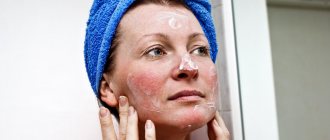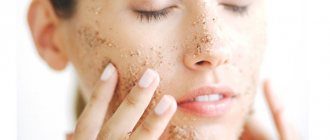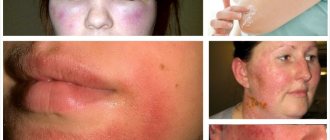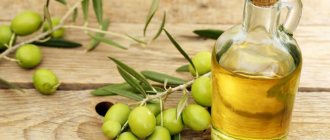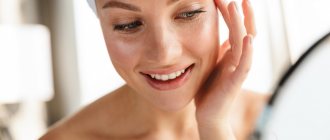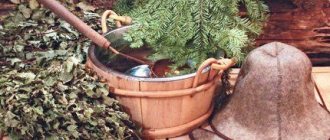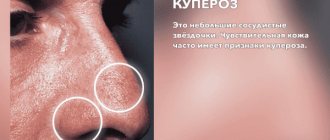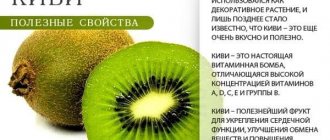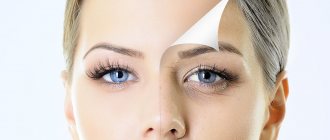Turmeric, or Indian saffron, is a plant from the Ginger family, common in Southeast India. Its stems and roots, which have a beautiful golden hue, are often used in cooking as seasonings. But women have found another use for spices - beauty and skin rejuvenation. In Asian countries, creams and face masks are prepared with turmeric. It is even included in luxury skin care products. We will talk about the benefits of turmeric for the skin and how to make a “golden” mask in our article today.
Beneficial properties of turmeric for facial skin
What are the beneficial effects of the spicy plant? Its secret is in its composition, rich in useful substances:
- vitamins C and E, known as “beauty vitamins”;
- essential oils;
- B vitamins, which give the skin a healthy color and elasticity;
- calcium, potassium, magnesium and other trace elements.
Using Indian saffron, you can increase local immunity, saturate the skin with vitamins and microelements, and destroy pathogenic microorganisms.
How to use turmeric oil?
Aromatic oil from this spice can be found in various cosmetics and perfume compositions. It can be combined with clove, ylang-ylang, sage, frankincense, cinnamon and nutmeg oils. It smells of spices with woody and peppery undertones.
- Due to its composition, turmeric oil is widely used in care products for normal to oily skin. You can use this oil in its pure form for skin care after sunbathing.
- Use turmeric oil for inhalation. In aromatherapy they treat increased mental stress and stress. You can use this product for massages. To do this, mix 5-7 drops of this oil with any other vegetable oil.
- To improve the quality of a cream or lotion, you can add 5 drops of this essential oil per 15 ml of base
- You can use this spice oil to relieve inflammation. To do this, mix 10 ml of carrier oil with 5 drops of turmeric oil. In this product you need to moisten gauze folded several times and apply it to the redness.
- As for contraindications, turmeric oil should not be instilled into the ears and nose, or used in a steam room.
Using Turmeric on the Face
As an antibacterial agent
Using turmeric at home is a good way to get rid of acne and pimples and relieve skin inflammation. Oriental spice has wound-healing and antibacterial properties. Face masks with turmeric help quickly treat pustules on the face, heal scratches, remove scars from acne and post-acne.
Anti-aging agent
Indian saffron actively suppresses the action of elastase, which is called the “aging enzyme”. Therefore, face masks and other anti-aging cosmetics with spices are invaluable for women over 50 years of age. With their help, you can significantly reduce wrinkles and restore skin elasticity and firmness.
And at a younger age, regular use of turmeric gives the skin a healthy glow, improves blood circulation, and prevents early wrinkles.
Cleansing and whitening
Golden spice is added to cleansing masks and facial lotions. It has the ability to penetrate deeply into pores and cleanse them of impurities and excess sebum. Turmeric is also a powerful skin whitening agent. If you use homemade cosmetics with Indian saffron regularly, you can cope with pigmentation.
Benefits for the skin
There are many healthy turmeric recipes. Their action is due to a number of unique properties. Among them it is worth highlighting the following:
- Stops inflammation. The components of the powder have pronounced antiseptic characteristics.
- Rejuvenates. The composition helps eliminate wrinkles.
- Makes the dermis lighter. The spice whitens the epidermis, helping to eliminate freckles and pigmentation.
- Soothes allergic reactions. The product also copes with the consequences of insect bites.
- Improves complexion. Using this product you can make your skin look healthier.
- Cleanses. By normalizing the functions of the sebaceous glands, the spice helps to cope with acne.
- Restores the epidermis. Spice helps speed up the process of regeneration of the dermis after traumatic injuries.
- Heals scars and scars.
- Copes with swelling.
- Opens the sweat glands. Due to this, toxic elements are removed.
Who should use face masks with turmeric?
Thanks to its rich composition, turmeric-based cosmetics are universal. They can be used for all skin types. The results of a course of masks are most noticeable with oily skin. The most suitable ingredients for preparing a mask with turmeric are clay, honey, essential oils, pulp and fruit juice. For dry skin, add cucumber or aloe juice and dairy products to the masks.
If the composition of a mask with Indian spice is selected correctly according to your skin type, you can use it to achieve:
- alignment of facial relief;
- removing traces of fatigue and stress;
- deep cleansing of pores;
- eliminates oily shine, blackheads and inflammation;
- lightening of scars and age spots;
- reduction of fine wrinkles.
Key provocateurs for the appearance of wrinkles in the eye area
Experts identify various factors that influence the appearance of wrinkles around the eyes. Among the main ones are frequent smiles or grimaces. Although emotions are necessary, it is important that active facial expressions do not overstrain the area around the eyes and do not provoke the appearance of wrinkles and creases in the skin.
Another factor contributing to the formation of wrinkles is poor vision, which causes frequent or almost constant squinting.
Sudden weight loss affects the condition of the skin of the body and face, including the area around the eyes. The tone decreases, small wrinkles appear.
The genetic predisposition to dry skin and sensitivity is especially pronounced where the epidermis is particularly thin. Therefore, the area around the eyes is one of the first to suffer.
Fatigue of the muscles of the periorbital zone can provoke an acceleration of the appearance of wrinkles; the problem is complemented by an incorrectly selected pillow for sleeping.
Improperly performed self-massage of the face can harm the skin, causing the development of wrinkles.
The appearance of wrinkles in this area can also be influenced by poor nutrition and drinking regimen, deficiency of minerals and vitamins, digestive pathologies and endocrine diseases, allergies (including to cosmetics).
Refusal to wear sunglasses provokes accelerated photoaging and constant squinting.
Bad habits, especially smoking, seriously affect the condition of the eyes. Stress and constant anxiety contribute to a certain extent. In addition to combating these factors, in modern cosmetology there are real ways to effectively remove crow's feet around the eyes.
Contraindications and precautions when applying a mask
Before you start making masks with turmeric, it is important to make sure there are no contraindications. Test for an allergic reaction. Like most natural products, turmeric is a potential allergen. A small amount of powder should be applied to the inner bend of the elbow for 20–30 minutes. If burning, redness, or itching occurs, do not use it.
It is important to know that cosmetics will not help if skin imperfections are the result of any disease. This is how gastrointestinal diseases and hormonal imbalances manifest themselves.
The reasons for refusing a course of masks with turmeric are:
- thin and sensitive skin;
- exacerbation of acne;
- severe peeling of the skin;
- the presence of pustules, inflammations, wounds on the face.
Contraindications
It is worth considering that the use of turmeric is not always allowed. Key restrictions on the use of spices for cosmetic purposes include the following:
- Individual intolerance. If you have allergic reactions to cloves, cinnamon and other spices, you will have to avoid them.
- Symptoms of rosacea. This disease is a direct contraindication to the use of turmeric.
- Too high sensitivity of the dermis, which is quickly subject to irritation. Otherwise, the turmeric product will cause itching and irritation.
- Purulent rashes. Applying and removing the substance will lead to the spread of pathogenic bacteria, which will cause problems and worsen the rash.
- Peeling. When using spices, they may get worse.
Those with very fair skin should use the substance in limited quantities.
This spice can cause yellow spots to appear on the face. To restore the natural shade of the dermis, it should be treated with citrus fruit juice. Lime, grapefruit, and lemon are perfect for this purpose.
How to prepare for applying a turmeric mask
Before preparing the mask, you need to buy high-quality spices. The turmeric packet should not contain any foreign substances. It is important to check the ingredients listed on the spice packaging.
To prepare cosmetics at home, take glass dishes and a wooden spatula so that the mixture does not oxidize. It is better to choose clothes and towels that you won’t feel sorry for, as products containing turmeric leave stains. Use gloves or a cosmetic brush to apply to avoid staining your skin and nails.
Sedative
If the skin around the eyes is irritated, it is recommended to use a gentle seasoning-based mask that will help eliminate this problem.
Required set of components:
- turmeric - 1/2 tsp;
- white yogurt - 50 ml;
- aloe juice - 5 drops;
- chickpea flour - 1 tbsp. l.
Initially, you need to mix the seasoning with yogurt and juice. Then gradually add flour until the mixture reaches a liquid consistency. Once ready, spread the mixture over the eye area and wait a quarter of an hour. Remove the mask with slightly warm water.
How to apply a turmeric mask
When using masks with Indian saffron, it is important to know how to make and apply them correctly:
- Before application, the face is cleansed.
- The exposure time of the mask should not exceed 15 minutes.
- The frequency of procedures is no more than 2 times a week.
- For fair skin, add a minimal amount of turmeric, take a pinch on the tip of a teaspoon.
- The compositions are applied immediately after preparation. They cannot be stored.
- To make the mixture homogeneous, without lumps, first thoroughly mix all the dry ingredients, and then add liquid ones (water, milk, juices, decoctions).
- If water is present in the mask recipe, use mineral water without gas or distilled water. Water can be replaced with cosmetic ice. It is placed in a container with dry ingredients and allowed to melt. With it, the mixture becomes more effective and soft.
- If one of the components of the mask is oils or honey, they are first heated in a water bath and added to the mixture last.
- The best time for procedures is in the evening. Overnight, yellowness and slight redness of the skin disappear.
- To wash off masks, use tampons soaked in water or milk. Oily skin is cleansed with kefir or lemon juice. Afterwards, wash off the face with warm water and apply day cream. For dry skin, a mixture of vegetable oil and flour is suitable.
- Masks are used in courses of 5–7 procedures.
- Apply the mixture with light patting movements. You cannot actively rub them into the skin.
- If itching or burning occurs, immediately wash off the product with water.
- Remove the mask with clean water, making sure that the composition does not get into your eyes.
Rules for using masks
In order for the mask to give a visible positive result, you must follow the rules of application:
- Prepare the selected recipe, observing the proportions.
- The average procedure time is no more than 15 minutes (unless a different time is provided by the prescription). It is not recommended to overexpose the masks - otherwise, an undesirable color of the dermis may appear.
- Apply the composition using a brush or wearing gloves (this way it will not stain your fingers and nails) only on a cleansed face.
- Don't forget to protect your clothes, as turmeric leaves stubborn stains.
- It is better to apply masks in the evening, which will help prevent the appearance of a yellow tint.
- After a cosmetic procedure, you should refrain from applying decorative cosmetics for two hours.
- The standard course of treatment is 20 procedures. You can use masks 2-3 times a week.
Light redness on the skin is a normal effect after such a mask. It goes away within 2–3 hours.
If turmeric has given the skin an undesirable color, lemon juice, kefir and oatmeal will help cope with the problem. The ingredients must be mixed and applied to the face for 15 minutes.
Any mask should be applied only along massage lines: this will avoid the appearance of early wrinkles.
If your facial skin is colored from turmeric
After applying the Indian saffron mask, the skin may take on a golden yellow hue. How to get rid of it? It is not at all necessary to use any means. The skin will return to its natural color on its own within a few hours. This is why it is advisable to make masks with turmeric in the evening or on weekends, when you are not going to go outside.
If you need to quickly remove the yellow tint, you can prepare a lotion. Take equal amounts of clean water and freshly squeezed lemon or grapefruit juice and wipe your face with it. For sensitive, dry skin, add 50 grams of oatmeal to a glass of kefir and apply to the face for a few minutes.
Rules for preparing homemade turmeric-based masks
In order for home procedures to give a positive result and not cause disappointment, you need to familiarize yourself with some recommendations. They will help you prepare and use the product correctly.
After all, there are also negative reviews on the Internet about masks with turmeric around the eyes, since many people forget that this is a seasoning, and it also contains irritating and aggressive substances. Therefore, only strict adherence to the rules for using the component will achieve the desired result.
Basic recommendations:
- To prepare a mask, you must use only a high-quality product from a trusted manufacturer, without the use of dyes and flavors.
- If you have concerns when initially using turmeric, you can reduce the amount of turmeric by half, and subsequently return to the indicated dosage.
- It is important to adhere to all specified standards in the recipe, since everything is good in moderation.
- The mask should be prepared in a ceramic or glass container, and it is better to use a whisk to combine the components.
- During the cooking process, you should initially mix the bulk ingredients, and only then gradually introduce liquid ingredients into them.
- Stir the mask until it has a uniform consistency so that there are no lumps.
- All manipulations during the cooking process must be carried out with gloves and an apron, so if the seasoning gets on your clothes, it will be impossible to wash it off.
- If the consistency of the product ends up being too liquid, you can add a little flour or soda to thicken it.
Recipes for face masks with turmeric
There are many recipes for masks with Indian spices for different skin types.
Turmeric with honey
One of the most effective is considered to be a composition with the addition of honey. It perfectly moisturizes, nourishes and protects the skin, smoothes out wrinkles.
For preparation take:
- ½ tsp. turmeric;
- 1 tsp. honey
The ingredients are poured into 2 tbsp. l. kefir or natural yogurt without additives. Thanks to dairy products, the mask can be used even for sensitive skin. It whitens and softens the skin after the first procedure.
Turmeric and ginger mask
To prevent the early appearance of wrinkles or smooth out existing ones, prepare face masks with turmeric, ginger and honey. This combination of components gives excellent results: the skin acquires tone, elasticity, and blood circulation improves.
For preparation you need:
- 1 tsp. turmeric;
- 2 tbsp. l. ginger root, grated on a fine grater;
- 2 tbsp. l. honey
The components are mixed until smooth. It can be kept on the face for no more than 10 minutes, as the mask has a warming effect.
Turmeric with milk
Recipes for homemade cosmetics with the addition of milk help restore youth and freshness to the skin. Mature skin benefits from masks from:
- 1 tsp. turmeric;
- 20 ml milk;
- 2 egg yolks;
- 15 g cottage cheese.
The cottage cheese is ground with egg yolks, spice is added, and then milk is poured in. The mixture is applied in a thick layer to the face and left for 20 minutes.
Turmeric with vegetable oil for dry skin
Dry skin is susceptible to the formation of age-related and facial wrinkles, and peeling. Cosmetic mixtures prepared at home with Indian spices help eliminate these shortcomings.
Ingredients:
- 2 tsp. turmeric;
- 2 tbsp. l. olive or any other vegetable oil;
- 4 drops of aromatic oil.
Pour vegetable oil into a container, add spices and aromatic oil. After thorough mixing, apply to the skin for 15 minutes. Wash off the product first with warm clean water, and then with kefir and again with water. The composition with turmeric cleanses, nourishes the skin, and improves metabolic processes.
Indian spice with aloe
Another option for masks for dry skin is suitable for nutrition and against flaking:
- a pinch of turmeric on the tip of a teaspoon;
- 1 tsp. honey;
- 2 tsp. aloe juice
The ingredients are mixed until smooth, applied to the skin for 10 minutes, and washed off with water.
For problem skin
A one-component mask made from Indian saffron will help problem skin with rashes and blackheads. The spice is diluted with water to a pasty state and lubricated with it on problem areas. After drying, the product is washed off with water.
Turmeric with sour cream
Another composition that saves problematic skin from scars and scars that remain after acne:
- ½ tsp. turmeric;
- 2 tbsp. l. sour cream;
- 1 tbsp. l. pea flour.
The mixture is thoroughly mixed until smooth and left on the face for 20 minutes.
Turmeric with almond flour
Ingredients:
- ½ tsp. turmeric;
- 2 tbsp. l. almond flour;
- 3 tbsp. l. mineral water without gas
- 4-5 drops of lavender essential oil.
All components are mixed, adding dry ingredients first and then liquid ones. The prepared pulp is kept on the skin for 15-20 minutes. Wash off with warm water.
Turmeric with chickpea flour for oily skin
The combination of Indian saffron with chickpea flour and rose water has beneficial properties: disinfects, relieves inflammation, eliminates acne. The consistency of the mask resembles a scrub. It not only cleanses oily skin, but also removes excess sebum and prevents clogging of pores.
Components:
- 1 tsp. turmeric;
- 2 tsp. chickpea flour;
- rose water to form a paste.
The spice is mixed with flour, rose water is added until a thick mixture is obtained. The mask is applied to the skin, paying special attention to problem areas. After 10–15 minutes, rinse with cold water and dry the skin with a napkin or towel. Afterwards apply a light moisturizer.
Turmeric with black clay
Masks made from Indian spices with various types of cosmetic clay have a cleansing, anti-inflammatory, and tightening effect.
To prepare the mask you need:
- 1 tsp. turmeric;
- 1 tsp. black clay;
- water until a paste is obtained;
Dilute the paste and apply to cleansed skin, after 8-10 minutes rinse with warm water. To enhance the effect, you can add sesame oil. The product has cleansing properties, so it is suitable for teenagers in the fight against problem skin. It can be used in courses of 7–8 procedures.
It is very convenient to use a set for diluting masks, which includes a bowl, brush, spatula and spoons.
The use of turmeric in cosmetology
Turmeric is a spice that is the dried, specially processed and crushed roots of the Curcuma Longa tree of the same name, known in its homeland as turmeric or yellow ginger, which grows mainly in India and Southeast Asia. It belongs to the Zingiberaceae family, so the beneficial properties of turmeric and ginger are very similar. There is something in common in the taste and specific aroma. The main difference is the color: turmeric contains the natural dye curcumin, which is a beautiful golden-orange color.
Turmeric is one of the most popular oriental spices
Women living in the homeland of the plant have long appreciated the potential of turmeric and widely use it not only in cooking, but also in cosmetology. In India and Southeast Asia, the spice is even called “women's spice.” The unique composition of the product allows you to solve many skin problems.
In India, the use of turmeric is not limited to cooking.
Healthy Ingredients:
- ascorbic acid (increases skin immunity, helps preserve its youth, maintains capillary tone, maintains their elasticity);
- phytomenadione (necessary for normal metabolism and supply of tissues with oxygen, nutrients, fights swelling, returns the skin a natural even tone and fresh appearance);
- niacin (participates in the processes of tissue regeneration and renewal);
- folic acid (increases skin resistance to adverse environmental conditions and other external influences);
- choline (reduces excess sebum production);
- pyridoxine (stimulates the production of natural collagen and elastin, necessary to maintain youthful skin);
- Omega-3 polyunsaturated fatty acid (activates the process of supplying tissues with oxygen);
- curcumin (a powerful antioxidant useful in the fight against inflammation, redness and other skin imperfections);
- essential oil (a natural antiseptic that quickly relieves irritation and fights pathogenic microflora);
- iodine, phosphorus, potassium, iron, magnesium, zinc, selenium (almost all of these microelements are vital for the skin, and it is difficult to get them in sufficient quantities from food).
The beauty benefits of turmeric are recognized not only by traditional medicine, but also by the official cosmetics industry.
What effect can you expect from a properly selected mask:
- disappearance of the unpleasant feeling of dryness and tightness;
- leveling the consequences of lack of sleep, signs of fatigue, stress;
- alignment of facial relief;
- return of even skin tone, healthy glow;
- deep cleaning and narrowing of pores;
- disappearance of greasy shine, blackheads, pimples, blackheads, inflammation and other imperfections characteristic of oily and combination skin;
- lightening of age spots, freckles, acne marks (with constant long-term use, you can even make scars more invisible);
- noticeable reduction of fine expression wrinkles;
- restoration of elasticity to the skin, return of dry and flabby tone, and clarity to the oval of the face.
Video: fighting hyperpigmentation with turmeric
Of course, only a high-quality product will be beneficial for the face. Choose your spice very carefully. The rich composition provides a quick and pronounced effect. Active components penetrate deep into tissues. Before “prescribing” yourself a course of masks, make sure that you have no contraindications for them and consult with a cosmetologist who will help you choose the ingredients that are most suitable for your skin type and its characteristic problems.
Take the time and effort to find quality spices
The mask will not work if problems with facial skin are a concomitant symptom of any disease. Most often, hormonal disorders and pathologies of the gastrointestinal tract manifest themselves this way. Therefore, consultation with a specialist in the relevant field will also be required.
Homemade turmeric masks are effective in many, but not all cases.
The use of turmeric for aesthetic purposes is not limited to the face. Spice paste inhibits hair growth when used regularly. It is also effective in combating stretch marks and rough skin on the elbows and heels. And turmeric oil quickly heals wounds, burns, abrasions, insect bites, irritation caused by allergies, and is widely used in aromatherapy, having an amazing aroma. It is also useful as an integral part of the treatment of dermatological diseases.
Its use in cosmetology is not limited to applying masks with turmeric to the face.
Video: beneficial properties of turmeric
Turmeric for teeth whitening
The powder of this oriental spice is often used to lighten the skin. But, it can also be used for home teeth whitening. There are several recipes for the mixture to give them a dazzling shine. One of them is like this.
- You need to take turmeric, salt and lemon juice and mix the ingredients to form a thick paste. She needs to brush her teeth no more than once a day. The course of lightening with this spice should not exceed 2 weeks
- If you have sensitive enamel, you should exclude lemon juice from this product. Its acid is extremely dangerous for teeth. If you are afraid for their condition, then you can simply clean them with turmeric powder. No added salt or lemon juice
Hair coloring with turmeric
The described spice is also widely used for hair coloring. In addition to giving your hair an original shade, this spice can:
- Make hair silky and shiny
- Eliminate inflammation of the scalp
- Strengthen hair follicles
IMPORTANT: This spice can be used as a hair growth remedy. To do this, it is mixed in equal quantities with henna and cinnamon. You can add a little red pepper to this mixture. This product should be used 3-4 times a month. In addition to accelerated hair growth, this product can increase its strength, volume and shine.
- To dye your hair with turmeric, you need to follow the same rules as when working with store-bought hair dyes. That is, you need to work with gloves and keep it on your hair for no more than 20-25 minutes.
- With this spice you can lighten your hair several shades. To do this, you need to mix turmeric (5 g), chamomile (4 tablespoons) and the zest of two lemons. The mixture is poured with boiling water (800 ml) and infused. After which you need to apply it evenly to dry hair and put on a cap.
